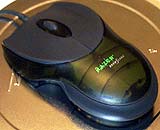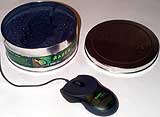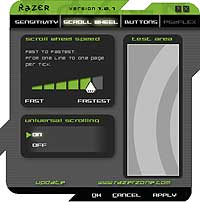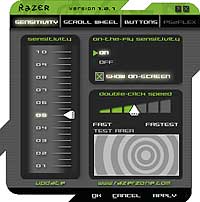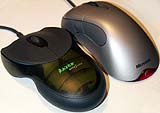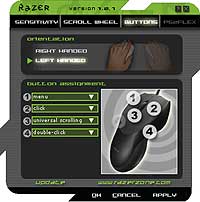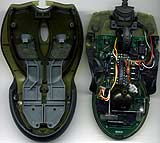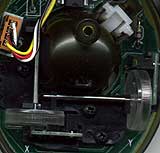
Razer Boomslang 2000 mouse
Review date: 19 December 1999.Last modified 03-Dec-2011.
OK, let's get Question Number One out of the way: What's a Boomslang?
It's a poisonous African tree snake, all right?
It's also the name of arguably the funkiest pair of mouses ever made. A company called kärna LLC (yup; no capital letter, AND an umlaut over the "a"...) makes them; the Razer mouses are the first product to use their remarkably high-resolution encoder technology. This "kärna Precision" technology gives these two mouses unprecedented resolution; the two models of Boomslang are called the 1000 and the 2000, because that's the dot per inch (dpi) resolution they offer. Move the mouse one inch, and the encoder increments 1000 or 2000 times.
I checked out the Boomslang 2000. It's cosmetically the same as the 1000, except its case is translucent green. The 1000 is grey. Both mouses work with either a USB or PS/2 connector.
The Boomslang mouses are only sold by mail order over the Internet. You can find US and European stockists at Razer's page here; Australasian purchasers can buy them from Silicon Horizon in Singapore.
The Boomslang 1000 costs a mere $US69.99; the 2000 sells for $US99.99. Silicon Horizon charges $US127.99 in total, including shipping to Australia; that's more than $AU200. Even without the shipping, they're still easily the most expensive PC mouses on the market.
Even at a hundred U.S. bucks, though, the Boomslang 2000 is not that expensive as computer peripherals go. If it truly is the greatest gaming mouse ever made, then it'll be one of the cheaper components of the high-end PCs assembled by game nuts.
The Boomslang prices are made a bit less painful by a software bundle - as I write this, Boomslang buyers can get either Soldier of Fortune or Battlezone 2 along with their mouse at no extra charge.
What you get
The Boomslang comes in what is best described as a sexy biscuit tin. Said tin is packaged in a cardboard box, presumably for stacking reasons or something, but the tin'll make an excellent, sturdy carry-case for people who've seen The Sting a couple too many times and want to make like a pool shark when they show up at a LAN party.
Unfortunately, there's no way to arrange the Boomslang so you have to screw it together like a pool cue after taking it out of its case, but I'm sure a later version will address this deficiency.
The Boomslang is a four button mouse, with two main buttons, a clickable "wheel doohickey", and another button on each side.
But that's five buttons, I hear you say.
Oh, no it isn't.
What's not immediately obvious is that only one of the two side buttons actually does anything at any given time; the mouse can be set to left or right handed mode by its driver software, and whichever button ends up under your thumb is the one that works. The side button on the non-thumb side is pretty hard to press, anyway; you'd have to use your ring or little finger to do it.
The Razer's two main buttons are enormous. I can lay practically the entire length of my normal-sized index and middle fingers along them. Because of the central placement of the button microswitches, it's only slightly harder to press the back of the button than the front, so they don't restrict hand positioning.
The Kärna mouse's wheel doohickey has significantly higher resolution than other mouse wheels, with 36 clicks per rotation. My Logitech First Mouse's wheel has 24 clicks per rotation; the IntelliMouse Explorer has only 18. The Boomslang's wheel also has a very positive, "clicky" feel; it sounds like a mouse button as you use it, whereas every other mouse wheel I've ever used is silent, with a soft-touch feel. It has traction notches moulded in, too, unlike the smooth wheels on most mouses. The Explorer and the plain Intellimouse with IntelliEye also have ridged, high-traction wheel doohickeys.
The buttons and wheel all have a hard-rubber non-slip coating, and the same surface curves around the rear of the mouse, for a secure grip.
Along with the mouse itself, you get a funny-looking circular manual with a driver CD in the back of it.
The strange round manual is replete with statements concerning the awe-inspiring effect the Boomslang will have on your gaming skills, the endless riches and good fortune its use will bring you, and how hanging it over your bed will keep vampires away. Or attract them, if you're into that sort of thing. Between the we-are-cool-we-are-badasses stuff, though, there's everything you need to know about the mouse and its driver software.
You also get a PS/2 plug adaptor. Like Microsoft's recent mouses, the Razer mouses work with both USB and PS/2 connections. The (seven foot) cable terminates in a USB plug, and there's a PS/2 adaptor included. If you use the PS/2 interface, the mouse driver software lets you set the mouse sampling rate as high as 200Hz (or as low as 10Hz, though I've no idea why you'd want to do that); if you use the USB option, the sample rate is fixed at the 125Hz of all USB mouses.
A mouse sample rate substantially higher than your game frame rate makes a slight, but not massive, difference to the playability of action games. It's more noticeable in games with a mouse cursor - real time strategy games, for instance - or just plain desktop applications, where a high sample rate gives very obviously smoother cursor movement.
Software
The Kärna mouse's driver software is quite impressive. You have to install the software before you install the mouse, and it requires a reboot before you plug the mouse in, even if you're using it in USB mode. This is the case with various USB devices; once you've restarted Windows that one time, though, you can plug and unplug your USB gadget all you like without restarting again.
The driver's defiantly non-standard layout is in keeping with the Boomslang's look-at-me attitude; unlike many funny-looking interfaces, it actually works properly and does not appear to foul up Windows in any way.
The driver's also capable of updating itself over the Internet; just click the Update button and it'll check to see if a newer version is available.
The Boomslang software lets you assign macros, as complicated as you like, to any of the mouse buttons. It's thus easy to make any button do any task in any game.
The on-the-fly sensitivity adjustment feature lets you hold down the thumb button and roll the mouse wheel to set the Boomslang's sensitivity, with a simple on-screen display to show the setting. The display flickers oddly if you call it up while playing some games, but it always seems to work.
The higher sensitivity selections are perfectly suited to people who kill flies by picking them out of the air with chopsticks. Unlike high speed settings for regular mouses, though, the Boomslang's upper speed settings are still nice and smooth. It may take a minuscule movement of the mouse to move the pointer one pixel, but you can do it; wind up the sensitivity on your ordinary mouse so a similarly small movement shifts the cursor by the same amount and you'll find the smallest movement you can manage becomes a several-pixel hop.
A speed setting of about 2 to 3 on the 1 to 10 scale the Boomslang offers gave me similar response to the 7 setting I had previously been using with my Intellimouse Explorer.
The competition
Which brings us to one obvious competitor for the Boomslang mouses' market segment - Microsoft's similarly show-offish Intellimouse Explorer. The Explorer, which I review here, is an optical mouse that uses Microsoft's IntelliEye technology to allow it to work on almost any surface, not just special mouse pads. It will never get dirty, it tracks cleanly on uneven surfaces, it's got one more useable button than the Boomslang (the Explorer has two thumb buttons), and it sells for less - around the $US65 mark, street price; under $AU100 here in Australia.
In the resolution stakes, it's hard to compare the Explorer with the Boomslang, because the Explorer doesn't have a mechanical encoder. Its little camera takes 1,500 images per second of whatever the Explorer's sitting on, and so its resolution relates to the camera's resolution, or as much of the camera's resolution as makes it through the digital signal processing the Explorer does, anyway.
Set to its maximum Windows speed, the Explorer is quite a lot less sensitive than the Boomslang, but has still run out of encoder resolution. The pointer moves in little hops, not smoothly pixel-by-pixel. At this speed, though, I have a hard time using the mouse anyway, and greater smoothness wouldn't help me much. I guess I'm just not worthy of super-resolution mouses.
The Microsoft Intellimouse driver lets you set the Explorer's buttons to imitate various Windows-relevant keys; I have the side buttons set to Page Up and Page Down, and then just assign functions to those keys in games, and it works. But the Boomslang option is more powerful.
One section of the mouse market that's definitely not interested in the Explorer is those users unfortunate enough to be left handed. The Explorer is not completely unusable by lefties, but it's not far short of it. It tilts the wrong way, and the "thumb" buttons on the side become practically unpressable.
The Boomslang is not only symmetrical, but its driver software makes specific allowance for left-handed users. As well as deactivating the side button that can't be pressed, swapping the mouse's handedness also swaps the functions of the left and right buttons. This may or may not be what you want to happen - many lefties are, of necessity, used to using the same left and right button functions as right-handers - but it's easy enough to swap the buttons back again.
By the way, the Boomslang coexisted perfectly happily with the Explorer. And with a basic Logitech wheelie-mouse, for that matter. You can plug in as many USB mouses as you have USB ports, and Microsoft's Intellimouse software didn't disagree with the Razer driver, beyond a couple of moments of oddness when I was playing around with the mouse speeds.
Looking inside
The Boomslang is held together by three screws, two under the front slide-pads and one hidden inside the ball recess. The bottom folds out from the contoured top assembly easily once the screws are removed.
Inside, the mouse's wasp-waisted design makes for a well-populated circuit board. The wheel doohickey's has an unusual trailing-arm pivot design, but the most interesting assembly is kärna's peculiar encoder setup.
Every other opto-mechanical mouse I've ever seen uses slotted disks as encoders, with two pairs of sensors for each disk . The encoders on the Boomslang are more like little clear plastic bottle tops, with refracting ridges stamped on the outside edge like the ridges around the edge of a coin. A single sensor assembly straddles the edge of each encoder.
Using it
At first touch, the Boomslang feels pretty peculiar. But then, so does pretty much any new mouse; it's only after using a mouse for a while that you can judge whether it suits you, or might suit others but isn't your cup of tea, or is a straightforward ergonomic disaster (hands up everyone who remembers Commodore's stock Amiga mice...).
At first, I found the Boomslang very uncomfortable. I've got pretty ordinary-sized male hands, and I had trouble finding the proper way to hold the thing.
If I held it so my thumb and ring finger rested on the side buttons, my index finger couldn't reach the wheel doohickey. If I held it well forward, my wrist was too elevated. Eventually, I figured it out.
You've got to be a bit delicate with the Boomslang. The buttons have a light touch - you can nearly press them just by relaxing your hand - and the high sensitivity when you use the upper speed settings means very little muscle-power's needed to move the mouse. The high sensitivity settings, though, felt more than slightly fiddly to me in ordinary Windows applications.
The Boomslang wheel is very nice for game use, where you want to click forward or back a certain, usually small, number of times, to do something like weapon selection. It's more annoying for plain Windows use, where you often wind the wheel a fair few turns to scroll through a document. The Boomslang setup software lets you set the wheel to scroll up to a full screen per click, but I still prefer a nice soft-touch wheel that's easier to turn for basic Windows use.
How the Boomslang works for desktop applications is, of course, not tremendously important. Heck, if you've got USB then you can get a nice comfy Logitech or Microsoft or whatever mouse for desktop stuff and plug it in as well as the Boomslang. Games are what the Boomslang's all about, so I fired some up and had a go.
I spent some time kicking bot butt in Quake III Arena and Unreal Tournament with the Boomslang and, after a while, concluded that I prefer the Explorer. Perhaps it's because I'm no railgun god at the best of times, or because super-high speed settings just don't seem to work for me, but I couldn't get comfortable with the Boomslang. It never stopped feeling weird.
I got used to the Explorer quickly enough - and it's sure a funny shaped thing. I have no trouble at all switching between the Explorer and slimline Logitech mouses and standard Microsoft IntelliMouses with their bulbous bottoms. But the Boomslang is just too darned odd for me. You're meant to hold it with a very light touch, and set the speed high enough that no more than tiny, gentle movements are needed. Maybe I'm could get the hang of using a mouse that way, eventually. But it just seems too much like hard work.
I've seen other reviews of the Boomslang mouses, though, from people who loved them. It would appear to be a matter of personal taste.
Overall
If you buy one of these things sight unseen then you're taking a gamble. You may not have a choice about buying blind, though, unless some other Boomslang owner lets you play with one. Since retail sales appear to be out of the question for the time being, you'll never get to try one out in a shop.
When the makers say this isn't a mouse for everyone, they don't just mean that it's expensive and exotic and a mark of distinction. The Boomslang is maybe not as weird as its name, but it ain't far short.
This product is clearly not rubbish. It might even be good value for money. But I tried quite hard to like it, and I failed. If you can't get hold of one to evaluate, I suggest treating the Boomslang with as much caution as its namesake.
